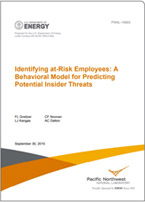 FL Greitzer, CF Noonan, LJ Kangas, AC Dalton
FL Greitzer, CF Noonan, LJ Kangas, AC Dalton
U.S. Department of Energy
Sinopse: A model was developed to assess employees’ behavioral manifestations of a number of psychological and personality predispositions that are hypothesized to indicate an increased risk of insider abuse. This psychosocial model is based on case studies and research literature on factors and correlates associated with behavioral precursors of individuals committing insider crimes. In many of these crimes, managers and other coworkers observed that the offenders had exhibited signs of stress, disgruntlement, or other issues, but no alarms were raised. Barriers to using such psychosocial indicators include the inability to recognize the signs and the failure to record the behaviors so that they can be assessed.
The model has been implemented as a Bayesian belief network, designed with the help of human resources staff experienced in evaluating workplace behaviors. We conducted an experiment to assess the agreement of the model’s risk assessment output with judgments of human resources and management professionals on the relative insider threat risks of a collection of sample scenarios. The model exhibited strong agreement with judgments of the human experts, suggesting that it has potential as a tool to raise an alarm about employees who pose higher insider threat risks. While additional testing is needed, we suggest that combining this type of analysis with more traditional cyber/workstation monitoring tools can ease the processing burden and improve performance of computer-assisted insider threat monitoring and detection.
